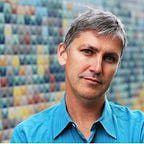The Shanghai Surprise: Urban Planning Is Sexy!
I’m writing this on the plane flying back after a ten day trip circumnavigating the globe. I started in Oxford (for the wonderful TEDGlobal conference) where my wife and I walked alongside the ancient wall built around the original town limits. I ended it taking the 200 mph MagLev train to the Shanghai airport. In other words, the trip started in the 12th century, and ended in the 22nd.
On my last morning in Shanghai, thanks to many Twitter recommendations, I visited the Urban Planning Exhibition. It’s justifiably famous for the vast scale model they have of the entire city. But what I was most struck by, however, was the rest of the exhibition — and the general fact that there was an entire museum, prominently located, devoted to the art and science of city planning. There were sections of the space devoted to Shanghai’s past that felt like other city museums I had been to. But what set this one apart was the top floor, which featured elaborate displays documenting the massive projects underway in the region: high-speed rail, the rapidly growing Pundong area, the revitalization of several urban riverfronts, and many environmental initiatives. This was not an archive of Shanghai’s past; it was an advertisement for its future.
If you happen to be a planning nerd, as I am, this was nirvana, an Apple Store of urban infrastructure. But I think the displays were exciting enough that you’d find it inspiring just as an ordinary citizen of the city. This is in part because you can already feel the positive impact that planning has had on the city — not just in that MagLev train, but also in the many delightful parks that have been build in the past decade or two in the downtown area. It got me thinking that we could use a comparable exhibition space in New York. We are in the middle of many epic projects in NYC right now: the massive riverfront designs, including Brooklyn Bridge Park, the Second Avenue Subway, the steady improvement of JFK, the million trees project. It is, empirically, the most active period of public works innovation since the heyday of Robert Moses. But it’s hard to see all those enterprises as a coherent unit, as something to be excited about. In fact, the opposite usually happens: they’re a construction site, complicating traffic, creating noise and chaos.
This is symptomatic of a larger problem, which is that states and central planners generally do a terrible job advertising their achievements. Every miraculous new toy that is produced by the marketplace (along with all the ordinary toys) arrives on the shelves with millions of dollars worth of advertising explaining how great it is, and how it will improve our lives. But the innovations that come from the public sector rarely have those promotional budgets. Every election year, we get ads telling us how great the politicians are, but we never get ads telling us how great Brooklyn Bridge Park is. That imbalance ends up cementing our existing assumption that markets are better than governments at improving our quality of life. But that isn’t always so. I’ll take one Brooklyn Bridge Park over a thousand new brands of detergent, thank you very much.
I realize this may sound a little odd coming from someone who wrote an entire book celebrating the power of bottom-up, distributed systems, a book that took the Jane Jacobs side in the Jacobs-vs-Moses dispute. I’m still a big believer in those decentralized forces, and indeed the streets of Shanghai are full of them. But you can’t self-organize a subway system. There are certain parts of urban life that will always have to be centrally planned (though hopefully with true community feedback along the way.) My point is that we could learn from the way Shanghai has celebrated its planners’ vision for the future of the city, in part because it’s fun to see all the cool stuff in the pipeline, and in part because it’s important to remind ourselves that governments can be a positive force for innovation and change too.
What’s fascinating in all of this, of course, is China’s communist history, and its long (and often dark) tradition of celebrating the achievements of the state. (It’s worth noting the urban planning exhibition is right off of People’s Square, and around the corner from Tomorrow Square, now populated by Ferrari dealers.) I suppose the argument could be made that states are already powerful enough; they don’t need marketing budgets. But I think if the achievements you’re celebrating are indeed real ones, whose benefits are shared by the wider population of the city, then creating something like the Exhibition of Urban Planning can make a lot of sense. I don’t pretend to know enough about contemporary China to evaluate whether there are exaggerations or omissions in Shanghai’s Exhibition. But I know enough about the plans underway in New York to think that the city could benefit from marketing its own achievements and ambitions. It’s not propaganda if you’re actually telling the truth.
